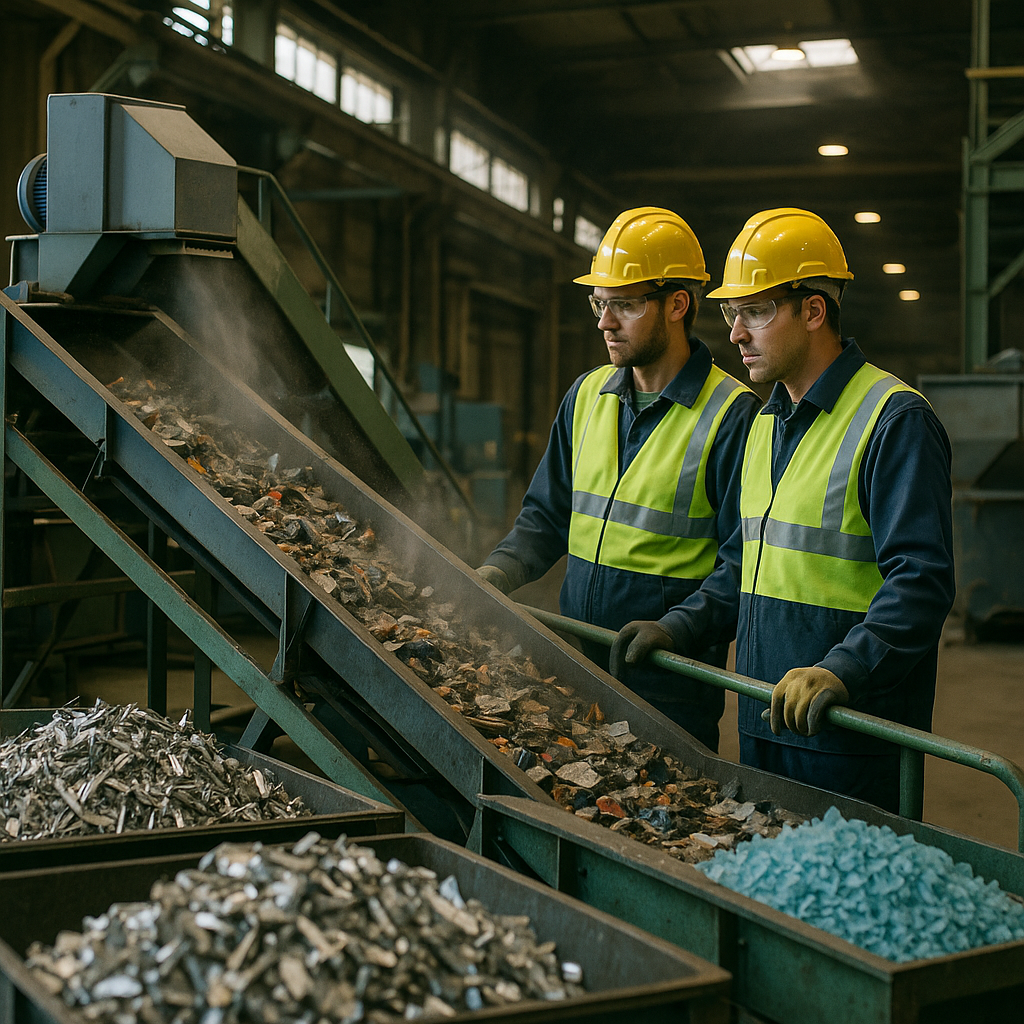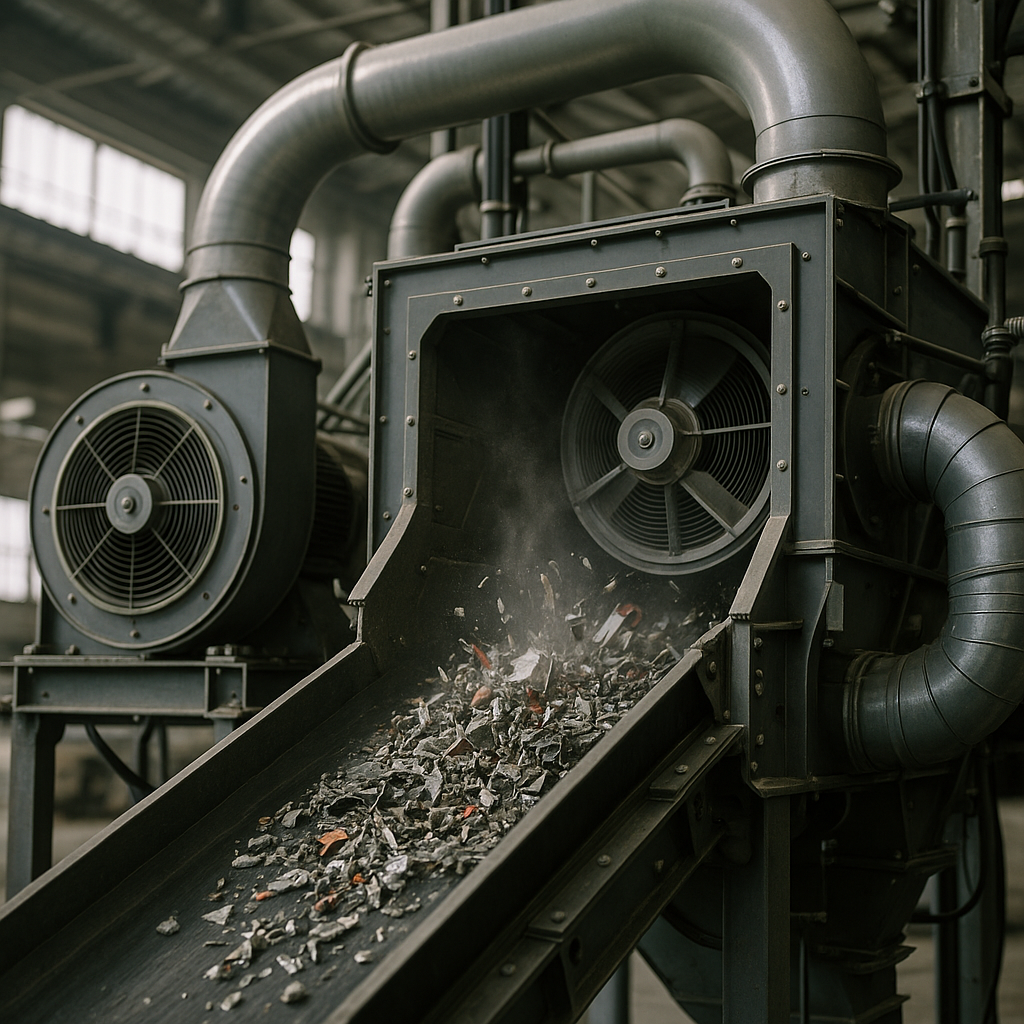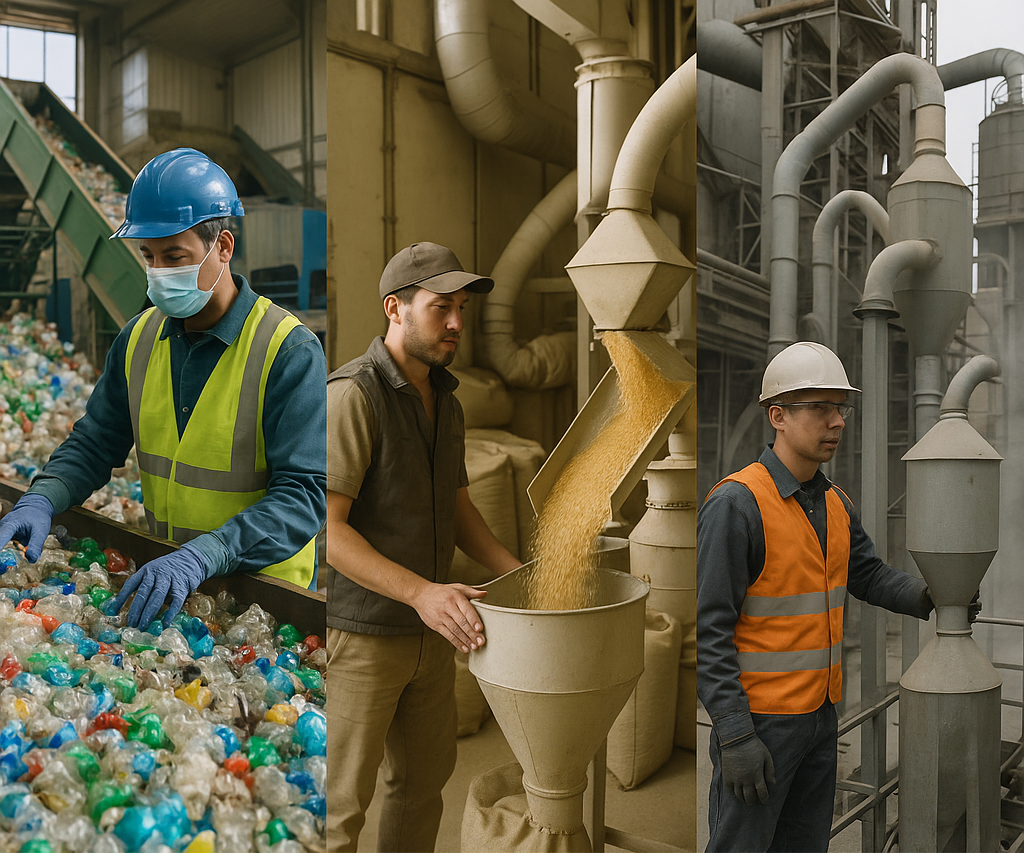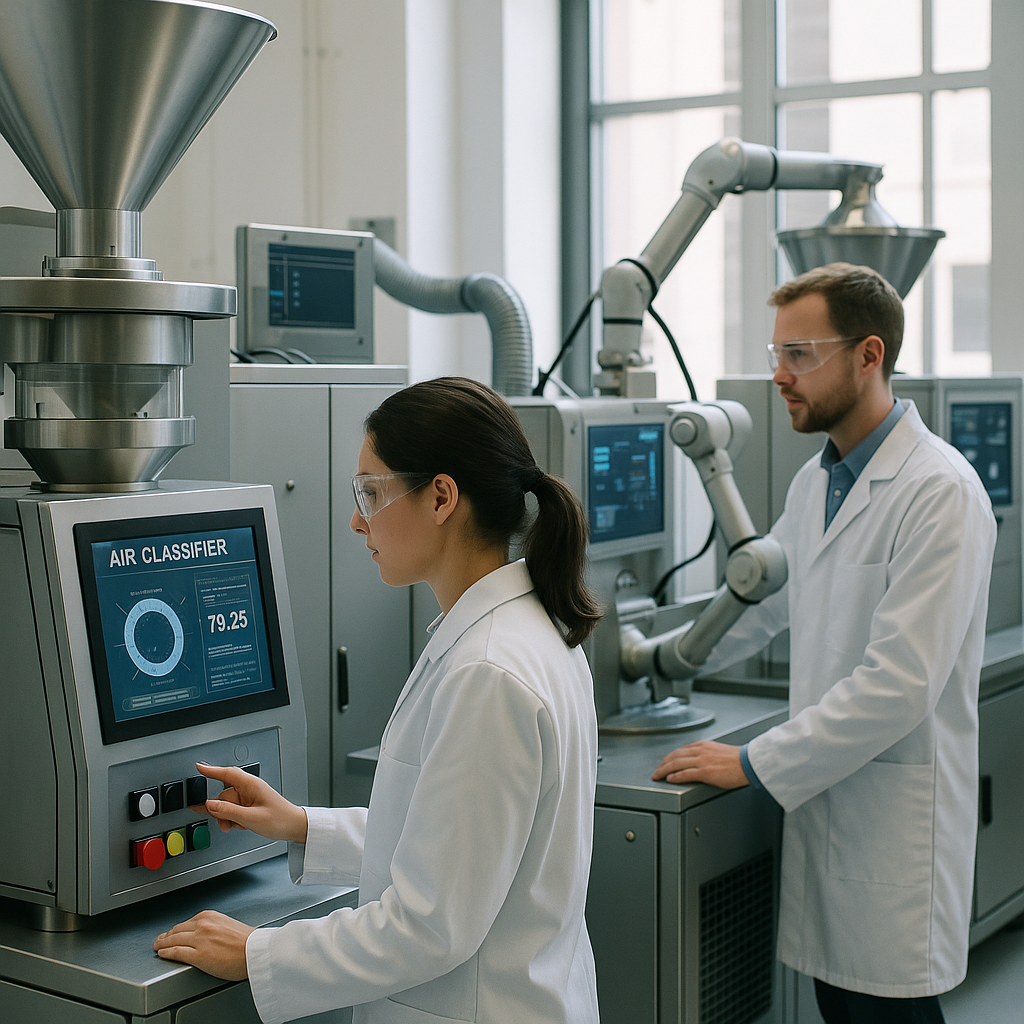5901 Botham Jean Blvd, Dallas, TX 75215
Air Classification in Scrap Processing: Technology, Components, and Industrial Applications
October 10, 2025Air classification is one of the most efficient methods in modern recycling for separating mixed materials. This innovative process uses controlled airflow to sort particles based on their size, shape, and density. When scrap materials enter an air classifier, they encounter a rising column of air that creates a sorting environment, allowing physics to do the work.
In its simplest form, air classification works by injecting material into a chamber with rising air. Inside this chamber, air drag counteracts gravity with an upward force. Lighter materials with larger surface area-to-weight ratios are lifted by the airstream, while heavier or denser materials fall. This results in natural vertical separation without the need for complex mechanical sorting.
This technique is essential in recycling facilities, where large volumes of mixed waste—metals, paper, plastics, and other materials—arrive together and require rapid sorting before further processing. For example, in automotive recycling, after crushing and shredding, air classification helps separate materials like plastics, foams, glass, and other non-metallic components. This separation process is crucial for maximizing resource recovery and minimizing landfill waste in our sustainability-focused world.
How Does Air Classification Improve Scrap Processing?

Air classification technology enhances scrap processing by using controlled airflow to separate materials based on density, size, and aerodynamic properties. This approach offers several advantages over conventional processing methods.
Enhanced Metal Recovery and Cleanliness
Air classification significantly improves the cleanliness of steel scrap by efficiently removing contaminants. When processing shredded auto-body material, the air classifier separates fibrous materials, rubber, dust, and other lightweight contaminants from the steel stream.
This process results in higher-quality ferrous material with reduced nonferrous contamination. Clean steel scrap fetches higher market prices and requires less processing by steel mills. Removing fibrous materials also enhances magnetic separation by preventing interference with the magnetic sorting process.
Elimination of Manual Sorting
A significant advantage of air classification is the elimination of hand sorting for final steel cleanup. The technology effectively removes contaminants like rags, rubber, and copper wire that would otherwise need manual removal.
This automation reduces labor costs and increases worker safety by minimizing exposure to potentially hazardous materials. Facilities can reallocate labor resources while maintaining higher throughput rates.
Improved Nonferrous Recovery
Air classification enhances the capacity and efficiency of nonferrous metal recovery operations. By separating the waste stream into distinct fractions based on density and aerodynamic properties, it creates concentrated streams of materials that are easier to process further.
The technology enables more effective processing of nonferrous metals like aluminum, copper, and zinc from auto shredder residue. This improved recovery results in increased revenue from previously wasted materials.
Key Environmental and Operational Benefits
- Reduced landfill waste – By separating materials more effectively, air classification can reduce the waste requiring disposal by approximately 50%.
- Lower dust content – Air classification removes dust more efficiently than air cascades.
- Dry processing – Unlike wet separation methods, air classification keeps materials dry, reducing weight and disposal costs.
- Increased throughput – The process increases system capacity by improving the efficiency of downstream equipment.
- Reduced dust collection costs – By removing dust early, the system lowers the size and expense of dust collection equipment.
Processing Efficiency for Auto-Body Scrap
Air classification is especially effective for processing shredded auto-body material. In conventional systems, magnetic separation leaves upholstery and other combustibles in the nonferrous stream. With air classification, these materials are removed before magnetic separation, enhancing overall process efficiency.
When the processing system includes nonferrous metal recovery, air classification reduces the size requirements of wet screening and flotation equipment. This allows facilities to handle larger volumes with existing equipment or expand capacity without significant capital investment.
Overall, the impact of air classification on scrap processing facilities includes lower operational costs, improved product quality, reduced environmental footprint, and enhanced recovery of valuable materials. These benefits make it an increasingly important technology for modern recycling operations focused on maximizing material recovery and minimizing waste.
What Are the Key Components of an Air Classification System?

An air classification system consists of several integrated components that work together to separate materials based on particle size and density. Each component serves a specific purpose in the overall process flow, from initial material preparation to final product collection.
Feed Preparation Units
Feed preparation equipment ensures materials enter the classification system with consistent characteristics. Shredders break down large materials into smaller particles, while screens provide initial sizing to remove oversized particles that could damage the system. Controlled feeding mechanisms like vibrating feeders or rotary distributors maintain a steady material flow into the classification zone, preventing surges that could compromise separation efficiency.
For optimal performance, feed preparation must produce particles with an appropriate size distribution. Some systems incorporate grinding mills in closed circuits with classifiers to continuously process materials until they reach the desired size.
Air Classification Column
The air classification column is the heart of the system where particle separation occurs. The zigzag column design is particularly effective, creating multiple directional changes that enhance separation. As material enters the column, particles experience competing forces: drag forces from moving air, gravity, and in some systems, centrifugal forces.
Inside the column, heavier particles fall downward as their mass overcomes air drag, while lighter particles are carried upward by the airstream. The zigzag configuration provides collision surfaces where particles impact and change direction, further improving separation. Some advanced systems incorporate adjustable deflectors or “buoys” positioned to optimize the separation point based on material characteristics.
Cyclone Separators
After classification, cyclone separators recover fine particles from the airstream. These conical devices create a vortex where centrifugal forces push particles outward against the walls while the air spirals upward through the center. Particles slide down the walls into collection hoppers while clean air exits through the top. Multiple cyclones may be arranged in series to improve collection efficiency, with primary cyclones handling larger particles and secondary cyclones capturing finer material.
Dust Collection Systems
Dust collection systems capture the finest particles that escape cyclone separators. These typically consist of fabric filters or baghouses where air passes through filter media that trap remaining particles. Modern dust collection systems often include automatic cleaning mechanisms that periodically pulse compressed air to dislodge collected dust from filters. These systems ensure both process efficiency and workplace safety by preventing particulate emissions.
In facilities processing valuable materials, dust collection becomes an important product recovery system rather than merely an environmental control measure.
Material Handling and Storage Components
Conveyor systems transport materials between different components of the classification system. These may include screw conveyors, belt conveyors, or pneumatic transport systems, depending on material characteristics. Storage units for both feed materials and separated products maintain process continuity and accommodate production variations. Properly designed storage silos include discharge aids like bin activators or fluidizing pads to prevent material bridging or ratholing.
Air locks and rotary valves maintain system pressure differentials while allowing material to enter or exit pressurized zones. These components prevent air leakage that could disrupt classification efficiency.
Control Systems
Modern air classification systems feature integrated control systems that monitor and adjust operating parameters. Sensors measure airflow rates, pressures, and material levels throughout the system. Programmable controllers automatically adjust fan speeds, feed rates, and classifier settings to maintain optimal separation despite variations in feed material. Some advanced systems incorporate analytical instruments that continuously measure product quality, allowing real-time adjustments to maximize yield and quality.
| Component | Function |
|---|---|
| Feed Preparation Units | Ensure consistent material characteristics, reduce size, and provide steady flow into the system |
| Air Classification Column | Separate particles by size and density using air drag, gravity, and centrifugal forces |
| Cyclone Separators | Recover fine particles from the airstream through centrifugal forces |
| Dust Collection Systems | Capture the finest escaping particles, ensuring process efficiency and safety |
| Material Handling and Storage Components | Transport materials between system components and accommodate process variations |
| Control Systems | Monitor and adjust operational parameters for optimal separation |
The efficiency of an air classification system depends on the proper integration of all these components. Adjustments to one component often require corresponding changes to others to maintain system balance. When properly designed and operated, these systems provide precise material separation while minimizing energy consumption and maximizing product recovery.
What Are the Applications of Air Classification in Different Industries?

Air classification technology is a versatile separation method used in industries where material sorting is critical. Its ability to separate materials based on density, size, and aerodynamic properties makes it invaluable in various applications. Let’s examine how different sectors leverage this technology for improved efficiency and resource recovery.
In municipal recycling facilities, air classification plays a crucial role in separating mixed waste streams. The technology efficiently separates lightweight materials such as paper, plastic films, and flexible packaging from heavier components like metals, rigid plastics, and glass without using water, thus reducing processing costs while achieving high-quality material recovery.
The automotive recycling industry heavily relies on air classification for processing end-of-life vehicles. After vehicles are shredded, air classifiers separate the resulting mixture into distinct streams. They effectively remove lightweight materials like foam and fabric from automotive fluff while isolating valuable nonferrous metals such as aluminum, copper, and zinc. This technology has transformed auto scrap processing by eliminating the need for manual sorting and increasing metal recovery rates.
Compost processing facilities benefit significantly from air classification systems. The technology removes unwanted contaminants like plastic fragments, glass, and small metal pieces from organic material. Air classifiers can handle compost with varying moisture content, making them ideal for processing aged stockpile material that requires cleaning before commercial sale, resulting in higher-quality compost products that meet strict horticultural standards.
Construction and Demolition Waste Applications
Construction and demolition waste recycling operations use air classification to separate materials of different densities. The technology effectively separates lighter demolition waste like wood pieces and plastics from heavier materials such as concrete, bricks, and metal, allowing for more efficient recovery of valuable building materials and reducing the volume of waste sent to landfills.
In the agricultural sector, air classification has evolved from its original purpose of separating chaff from wheat. Modern systems now process a wide range of agricultural products, removing husks from grains, separating corn fiber, and processing hemp and other fibrous materials. The technology’s capability to handle moisture-sensitive materials makes it particularly valuable for crops that require careful processing.
Industrial mineral processing operations employ air classification to sort minerals by size and density, creating precise particle size distributions without using water, which is especially important for moisture-sensitive materials. This dry processing capability allows for more efficient mineral recovery while minimizing environmental impact.
Fine Particle Management
Air classification excels at handling ultrafine powders that typically clog mechanical sieves. Industries dealing with fine particulates, such as pharmaceuticals and powder coating manufacturers, rely on this technology to achieve precise particle separation. By using controlled airflow rather than physical screens, air classifiers can process materials down to microscopic sizes without blockage issues.
Electronic waste recycling facilities use air classification to separate lightweight electronic components from heavier ones, isolating circuit boards, wires, and plastic casings from metal components. This precise sorting is crucial for recovering valuable materials like gold, silver, and rare earth elements from discarded electronics.
The energy efficiency of air classification makes it attractive across these industries. The technology separates materials using airflow and gravity rather than mechanical means, resulting in lower energy consumption. This reduced energy requirement, combined with the elimination of water use in many applications, contributes to both cost savings and environmental benefits.
The versatility of air classification continues to expand its applications as industries seek more efficient and sustainable waste management solutions. Its ability to process diverse materials with minimal maintenance requirements makes it a cornerstone technology in the evolving landscape of resource recovery and circular economy initiatives.
What Are the Future Trends and Developments in Air Classification Technology?

Air classification technology is undergoing significant transformation as manufacturers focus on improving efficiency, reducing energy consumption, and enhancing separation precision. Recent innovations are changing how recycling facilities process and recover materials, offering more sustainable waste management solutions.
Advanced Sensors and Control Systems
The implementation of sophisticated sensor networks represents a substantial advance for air classification systems. These sensors provide real-time monitoring of airflow patterns, material composition, and separation efficiency. Unlike traditional systems that operate on fixed parameters, modern classifiers use this continuous data stream to adjust operations immediately.
High-resolution cameras paired with spectroscopic technology can now identify different material types as they enter the classification chamber. This capability allows the system to automatically modify air velocity and separation parameters based on the characteristics of incoming waste streams.
Advanced pressure and temperature sensors also enhance operational efficiency by detecting changes in system performance. When variations that might affect separation quality are identified, the control system can implement corrective measures without human intervention.
New Classifier Designs for Enhanced Material Handling
Innovative air classifier designs are emerging to address the growing complexity of waste streams. Traditional systems often struggled with mixed materials or items with varying densities and shapes. New configurations feature multiple classification stages with customizable airflow patterns that can handle a wider range of materials simultaneously.
Modular classification chambers allow operators to quickly reconfigure systems for different waste streams. This adaptability is particularly valuable for recycling facilities that process varying material types throughout their operation.
Engineers are also developing more precise airflow control mechanisms, creating targeted separation zones within the classifier. These innovations significantly improve the recovery of valuable materials that might previously have been lost due to inefficient separation.
AI and Machine Learning Applications
Artificial intelligence is perhaps the most transformative development in air classification technology. Machine learning algorithms analyze vast amounts of operational data to identify optimal processing parameters for specific waste compositions.
AI-powered classification systems continuously learn from their performance, becoming more efficient over time. These systems can identify patterns in material flow and separation effectiveness that human operators might miss. For example, an AI system might recognize that specific combinations of airflow velocity and feed rate maximize the recovery of certain plastics.
Computer vision technology integrated with AI enables these systems to identify and sort different materials with remarkable precision. This technology can distinguish between various types of plastics, metals, and other recyclables based on visual characteristics that would be challenging for humans to detect.
Predictive analytics capabilities also allow these systems to anticipate maintenance needs and prevent costly downtime. By monitoring subtle changes in system performance, AI can flag potential issues before they cause operational disruptions.
Portable and Modular Systems
The trend toward more flexible waste management solutions has driven the development of portable and modular air classification systems. These compact units can be deployed in various locations, making advanced separation technology accessible to smaller recycling operations and remote facilities.
Mobile classification systems allow for on-site processing of materials, reducing transportation costs and associated carbon emissions. Construction sites, for example, can use portable air classifiers to separate recyclable materials directly at the source rather than shipping mixed waste to centralized facilities.
Modular designs also facilitate easier upgrades and maintenance. Instead of replacing entire systems, operators can update specific components to incorporate new technologies as they become available.
Environmental and Economic Benefits
These technological advancements deliver substantial environmental and economic benefits. Energy consumption, a significant operational cost for recycling facilities, is being reduced through more efficient motors and improved airflow dynamics. Some next-generation systems demonstrate energy reductions of up to 30% compared to conventional classifiers.
Higher precision in material separation leads to purer material streams, which command better market prices. This increased value recovery makes recycling operations more economically viable while diverting more waste from landfills.
The environmental impact extends beyond waste diversion. Efficient classification systems reduce the need for virgin resource extraction by recovering more materials. Additionally, the energy savings translate directly into lower carbon emissions from recycling operations.
The combination of these technological advancements promises to make air classification an even more valuable tool in the global effort to create circular material economies and sustainable waste management practices.
Conclusion: The Role of Air Classification in Sustainable Scrap Processing
Air classification is a key technology in modern scrap processing and recycling systems. In this article, we have explored how this innovative method uses directed airflow to sort materials by size, density, and aerodynamic properties without using water. This dry processing capability ensures precise material separation and significantly reduces energy usage compared to mechanical alternatives.
The technology’s versatility is evident in its ability to handle a wide range of materials—from automotive scrap and electronic waste to municipal solid waste and construction debris. By integrating seamlessly with other recycling technologies like magnetic and eddy current separation systems, air classification enhances the recycling ecosystem necessary for effective resource recovery. The environmental benefits are considerable, with reduced contamination, minimized waste disposal, and improved recovery rates for valuable materials that support circular economy goals.
For your recycling and sustainable materials processing needs, contact Okon Recycling at 214-717-4083. Our expert team can help implement advanced air classification solutions tailored to your specific material separation challenges.
